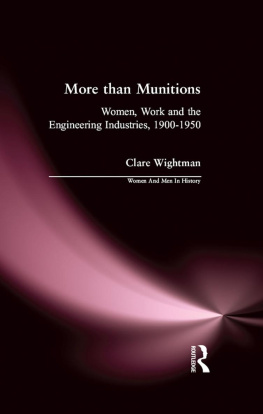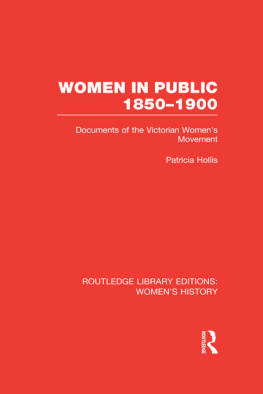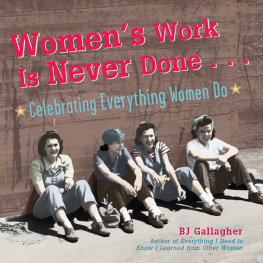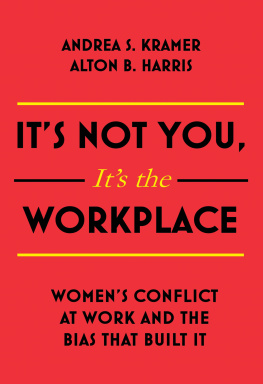More than Munitions
WOMEN AND MEN IN HISTORY
This series, published for students, scholars and interested general readers, will tackle themes in gender history from the early medieval period through to the present day. Gender issues are now an integral part of all history courses and yet many traditional texts do not reflect this change. Much exciting work is now being done to redress the gender imbalances of the past, and we hope that these books will make their own substantial contribution to that process. This is an open-ended series, which means that many new titles can be included. We hope that these will both synthesise and shape future developments in gender studies.
The General Editors of the series are Patricia Skinner (University of Southampton) for the medieval period; Pamela Sharpe (University of Bristol) for the early modern period; and Penny Summerfield (University of Lancaster) for the modern period. Margaret Walsh (University of Nottingham) was the Founding Editor of the series.
Published books:
Masculinity in Medieval Europe
DM. Hadley (ed.)
Gender and Society in Renaissance Italy
Judith C. Brown and Robert C. Davis (eds)
Gender, Church and State in Early Modern Germany: Essays by Merry E. Wiesner
Merry E. Wiesner
Manhood in Early Modern England: Honour, Sex and Marriage
Elizabeth W. Foyster
Disorderly Women in Eighteenth-Century London: Prostitution in the Metropolis, 17301830
Tony Henderson
Gender, Power and the Unitarians in England, 17601860
Ruth Watts
Women and Work in Russia, 18801930: A Study in Continuity through Change
Jane McDermid and Anna Hillyar
The Family Story: Blood, Contract and Intimacy, 18301960
Leonore Davidoff, Megan Doolittle, Janet Fink and Katherine Holden
More than Munitions: Women, Work and the Engineering Industries, 19001950
Clare Wightman
More than Munitions
Women, Work and the Engineering Industries, 19001950
CLARE WIGHTMAN
First published 1999 by Addison Wesley Longman Limited
Published 2014 by Routledge
2 Park Square, Milton Park, Abingdon, Oxon OX14 4RN
711 Third Avenue, New York, NY 10017, USA
Routledge is an imprint of the Taylor & Francis Group, an informa business
Copyright 1999, Taylor & Francis.
The right of Clare Wightman to be identified as author of this Work has been asserted by her in accordance with the Copyright, Designs and Patents Act 1988.
All rights reserved. No part of this book may be reprinted or reproduced or utilised in any form or by any electronic, mechanical, or other means, now known or hereafter invented, including photocopying and recording, or in any information storage or retrieval system, without permission in writing from the publishers.
Notices
Knowledge and best practice in this field are constantly changing. As new research and experience broaden our understanding, changes in research methods, professional practices, or medical treatment may become necessary.
Practitioners and researchers must always rely on their own experience and knowledge in evaluating and using any information, methods, compounds, or experiments described herein. In using such information or methods they should be mindful of their own safety and the safety of others, including parties for whom they have a professional responsibility.
To the fullest extent of the law, neither the Publisher nor the authors, contributors, or editors, assume any liability for any injury and/or damage to persons or property as a matter of products liability, negligence or otherwise, or from any use or operation of any methods, products, instructions, or ideas contained in the material herein.
ISBN 13: 978-0-582-41435-8 (pbk)
British Library Cataloguing in Publication Data
A catalogue entry for this title is available from the British Library
Library of Congress Cataloging-in-Publication Data
A catalogue entry for this tide is available from the Library of Congress
Set by 35 in 10/12pt Baskerville
Contents
Some theoretical issues
AEU | Amalgamated Engineering Union |
ASE | Amalgamated Society of Engineers |
ASI | Amalgamated Society of Instrument Makers |
BSA | Birmingham Small Arms |
BTH | British Thomson-Houston |
EEF | Engineering Employers Federation |
ETU | Electrical Trades Union |
GEC | General Electric Company |
GMWU | General and Municipal Workers Union |
GPO | General Post Office |
GWR | Great Western Railway |
NFWW | National Federation of Women Workers |
NUFW | National Union of Foundry Workers |
NUGMW | National Union of General and Municipal Workers |
NUGW | National Union of General Workers |
NUVB | National Union of Vehicle Builders |
TGWU | Transport and General Workers Union |
TUC | Trades Union Congress |
WU | Workers Union |
It is both a relief and a pleasure to be able to acknowledge publicly those who have helped to bring a piece of research to fruition. First among my archival debts is the Modern Records Centre at the University of Warwick, a unique and important repository whose staff were supportive in many ways. They are probably as relieved as I am at this books completion. The following archives also deserve thanks: British Motor Industry Heritage Trust Archive and Library, Coventry City Archives, Local Studies Department, Coventry City Library, Birmingham Reference Library and Birmingham City Archives, the Institution of Electrical Engineers, Manchester City Archives and the Public Record Office. I am very grateful to several firms for making their records available to me, including GEG-Alsthom (Electro-mechanical) Trafford Park, Manchester and Lucas Industries, Pic, Solihull. Thanks are also due to all those former employees of GEC, Lucas and Metropolitan-Vickers who offered recollections of the engineering industry and help in locating records. The Engineering Employers Federation, The Transport and General Workers Union and the Amalgamated Engineering and Electrical Trades Union also allowed me access to their archives.
Jim Obelkevich has always provided kind hospitality. For their intellectual guidance and help I am especially indebted to Joanna Bourke, Michael Dintenfass and Jonathan Zeitlin. For support of the most valuable kind, however, my final debt is to my husband, Tony Mason.
The engineering industry is, and must always be, primarily an industry for men.1
The authors of a report made to the Engineering Employers Federation (EEF) in 1934 were right the industry predominantly employed men and it continued to do so. At its peacetime height in 1946, only a fifth of the workforce was female. In terms of womens employment as a whole, engineering accounted for only a minority of workers. In 1900 most women worked in either domestic service, textiles or garment making. Later they worked mainly in the white collar and service industries. No more than 3 per cent of all women in the major occupational groups worked in the engineering industry.2 Numerically small, female employment was not insignificant however. After 1919, women and girls made up an increasing share of the workforce in the industrys fastest growing and most productive sector the new industries of electrical goods, light engineering and vehicles.








